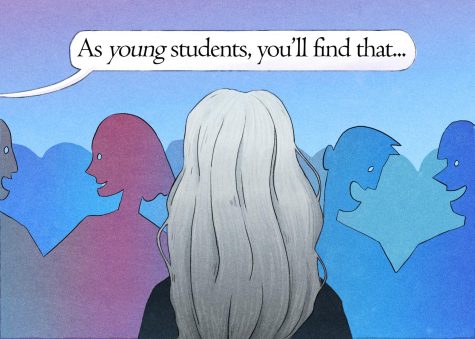Opinion: Tuition increases especially rough on nontraditional students
November 30, 2022

Being a nontraditional student at Columbia College Chicago can be a lonely experience.
During my first-semester orientation, there was no mention of services or events a person my age might feel comfortable making an appointment for or attending. In classes, professors always unconsciously default to “as young students, you all will find that…” language.
Not having Columbia staff acknowledge the special concerns of older students, financial or otherwise, does not feel good. I do not feel they would know how to address my issues because they are not trained to do so, so I do not mention my problems.
According to Univ Stats, in the 2020-21 academic year, of 6,769 students at Columbia, there were 15 undergraduate students between 50 and 64 years old and one undergraduate student over 64. As a soon-to-be 64-year-old student at Columbia, loneliness aside, this statistic sets my outlier status in stone.
Doubling down on Columbia’s lack of nontraditional student recruitment, the school’s planned 5% tuition increase for the 2023-24 academic year, following a 10% increase for this year, could cause nontraditional students like myself to leave Columbia in search of a more welcoming and affordable environment.
In order to finance my tuition at Columbia, my husband and I agreed to use money we saved over 30 years to fund our lives after his retirement this past September.
Going forward, we realized taking two, three-credit-hour classes per semester, at a cost of $12,132 per year, isn’t sustainable notwithstanding the coming increase in tuition.
Every year at school, I receive emails about applying for financial aid, but the idea of owing so much money after graduation at my age did not make sense, based on financial headwinds I witnessed younger, traditional students facing.
According to the U.S. Department of Education’s College Scorecard, last updated in September 2022, 31% of Columbia undergrad students owe more money than the amount of their original loan due to interest and accrued interest two years after beginning repayment. Columbia’s fiscal year statistic indicates mean undergraduate debt after graduation is $31,940.
In 2021, 52% of Columbia students were recipients of institutional grants for full-time students, emphasizing the school’s push for younger students who can attend full time. I don’t meet the eligibility requirement for these grants because I cannot attend school full time, due to the necessity of work. I have looked into outside scholarships and the full-time registration eligibility requirement is the norm.
The Free Application for Federal Student Aid should also be overhauled to increase student inclusion. The federal student aid program is, for example, based on parental income. I do not have parents anymore.
Ironically, by increasing tuition to make our school financially solvent to fund student classes, pay for professors and support services, the increase prompts me to consider leaving Columbia.
We are plentiful and diverse. We tend to work full time while going to school, we can be low-income, military personnel, working parents or commuters.
Thirty-nine percent of nontraditional students aged 40 and above attend school part-time. We are more likely to take online classes and can be financially independent.
According to Insight Into Diversity, a publication which writes about diversity issues in higher education, lack of technology knowledge is a major factor for nontraditional students over 40 seeking higher levels of education. Pandemic-related job losses caused nontraditional students to move from leisure learning to seeking higher education degrees for survival.
As of 2020, “one in 10 college students is 40 or older, and by 2027, 3.3 million students will fall within this age group,” according to the National Center for Education Statistics.
Shifting to a targeted, intensive plan to recruit and retain more nontraditional students could help Columbia increase enrollment and solve financial issues hinted at by successive tuition increases.
I do not want to leave Columbia. I am close to achieving my dream of becoming a freelance journalist and having a full-time job with health benefits for my husband and myself.
To be clear, my support comes from my professors, classmates and above all, the Chronicle staff and management. But Columbia’s focus on youth affects my sense of belonging to the larger community and having school pride.
Our school exults in diversity, equity and inclusion, but its lack of marketing, services, scholarships and events and absence of a dedicated staff members to address the unique needs of nontraditional students, says otherwise.
I just want to belong, and seeing me would be a good start in getting me to graduation.







